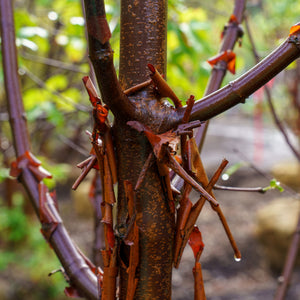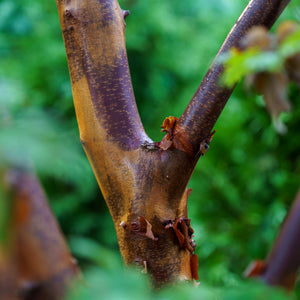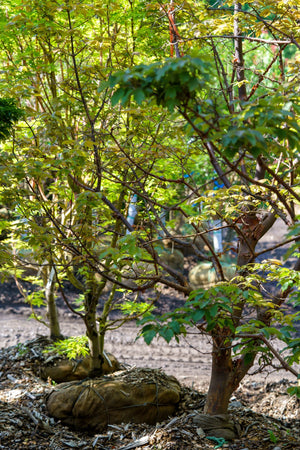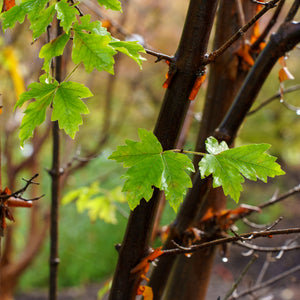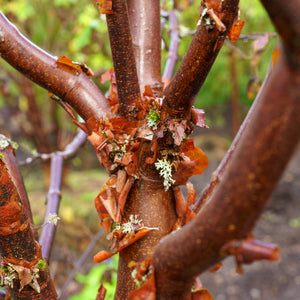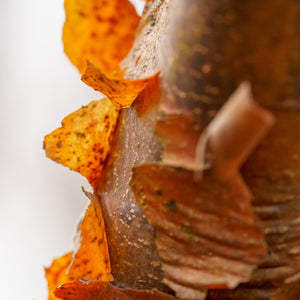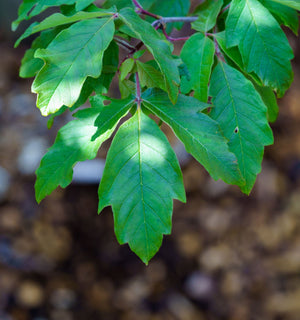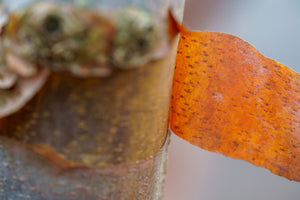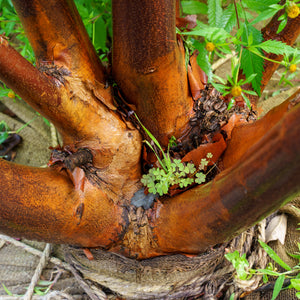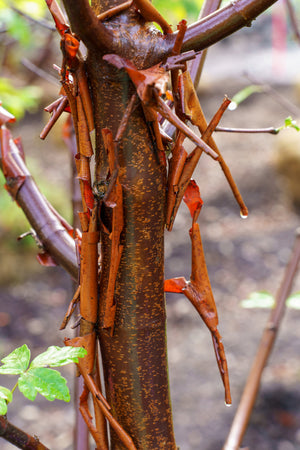Paperbark Maple: Stunning Fall Color & Exquisite Bark
Welcome to another edition of our "Plant of the Week" series! This week, we are thrilled to showcase the captivating Paperbark maple (Acer griseum). Prepare to be mesmerized by the enchanting qualities of this remarkable tree. With its distinctive features and undeniable charm, the Paperbark maple is a favorite choice for gardeners and landscape enthusiasts. Join us as we explore the fascinating characteristics and benefits of this remarkable tree, and discover why it's a must-have addition to any outdoor space.
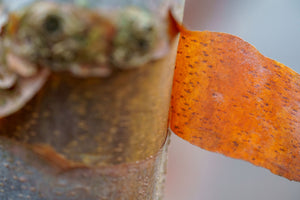
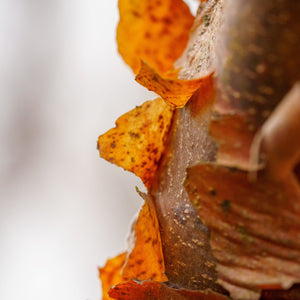
WHAT MAKES PAPERBARK MAPLE SPECIAL?
The Paperbark maple is a truly exceptional tree that stands out in any landscape. Renowned for its stunning features, this tree is a testament to nature's artistry. One of its most remarkable attributes is its distinctive cinnamon-colored bark, which peels away in thin, papery sheets, creating a captivating display of texture and color. This unique characteristic not only adds visual interest throughout the year but also provides a striking focal point in winter when many other trees are dormant.
But the Paperbark maple doesn't stop there. Its trifoliate leaves, composed of three lobes, are a rich green during the growing season, transforming into vivid shades of red, orange, and bronze in the fall. The fiery foliage creates a breathtaking spectacle, painting the landscape with warm hues and infusing it with a sense of vibrancy and beauty.
This small to medium-sized tree also boasts an elegant and well-rounded form, making it an excellent choice for both urban and rural environments. Whether used as a standalone specimen or incorporated into a mixed planting, the Paperbark maple's graceful silhouette adds depth and dimension to any garden or landscape design.
Another notable characteristic of the Paperbark maple is its adaptability. It thrives in various soil types and tolerates both full sun and partial shade, offering flexibility in placement. Additionally, this tree is known for its resilience, withstanding urban pollution and demonstrating good resistance to pests and diseases. Its hardiness and low-maintenance nature make it an ideal choice for homeowners and gardeners seeking a tree that requires minimal effort while delivering maximum impact.
The Paperbark maple is an extraordinary tree that captures attention year-round. From its enchanting peeling bark to its stunning fall foliage, it adds a touch of elegance and natural beauty to any landscape. Whether used as a focal point, a shade tree, or an accent in a mixed planting, the Paperbark maple is sure to leave a lasting impression and become a cherished addition to your outdoor space.
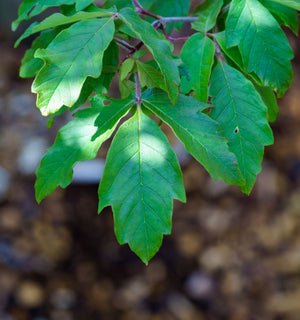
WHAT IS PAPERBARK MAPLE USED FOR?
The Paperbark maple is a tree that offers both aesthetic beauty and practical value. While it is primarily cultivated for its ornamental use, its benefits extend beyond its visual appeal. Here are some of the key uses and advantages of the Paperbark maple:
Ornamental Value: The Paperbark maple is highly valued for its striking features, including its distinctive cinnamon-colored peeling bark, fiery fall foliage, and elegant form. It serves as an eye-catching focal point in gardens, parks, and other outdoor spaces, adding depth, texture, and visual interest to the landscape.
Shade Tree: With its lush foliage and well-rounded form, the Paperbark maple provides excellent shade. Its dense canopy creates a cool and comfortable environment, making it an ideal choice for shading patios, decks, seating areas, and other outdoor spaces where people gather and seek relief from the sun's rays.
Urban Landscapes: The Paperbark maple exhibits a remarkable tolerance to air pollution, making it a valuable asset for urban environments. It can thrive in areas with poor air quality, such as cities and urbanized regions, where other tree species may struggle. By planting Paperbark maples in urban landscapes, you can enhance the beauty of the surroundings while contributing to improved air quality.
Pollinator Support: The early spring blossoms of the Paperbark maple, although tiny, provide a vital source of nectar for pollinators, including bees and butterflies. By attracting these beneficial insects, the tree actively contributes to the pollination process and supports local ecosystems. This promotes biodiversity and helps maintain a healthy balance in the natural world.
Overall, the Paperbark maple is a versatile tree with numerous applications. Its ornamental value, shade-providing capabilities, resilience to air pollution, and support for pollinators make it a cherished addition to gardens, parks, urban landscapes, and any outdoor space where beauty, functionality, and ecological value are desired.
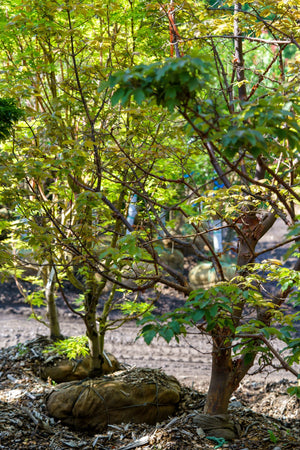
HOW TO CARE FOR PAPERBARK MAPLE
The Paperbark maple is a relatively low-maintenance tree that is easy to care for. By following these simple guidelines, you can ensure the health and vitality of your Paperbark maple:
Planting: Choose a location that provides well-drained soil and full sunlight for optimal growth. Although it prefers well-drained soil, it's adaptable to other types, including clay. It is best to plant the tree in the fall or early spring to allow it sufficient time to establish its root system before extreme weather conditions.
Watering: The Paperbark maple prefers slightly moist soil but avoid overwatering, as it can lead to root rot. Water deeply and thoroughly, especially during dry periods, ensuring the soil is evenly moist. However, be cautious not to let the tree sit in waterlogged soil.
Pruning: Pruning is generally not required for the Paperbark maple, as it naturally maintains an attractive shape. However, you can selectively prune the tree during the dormant season to remove any dead, damaged, or crossing branches. This will help maintain its structure and promote good air circulation.
Fertilizing: The Paperbark maple does not demand heavy fertilization. However, you can apply a balanced, slow-release fertilizer in the spring before new growth emerges. This will provide essential nutrients and support healthy growth and abundant flowering.
Mulching: Apply a layer of organic mulch around the base of the tree, leaving a gap around the trunk to prevent moisture accumulation and potential diseases. Mulching helps conserve moisture, regulate soil temperature, and suppress weed growth.
Protection: Paperbark maple trees are generally hardy, but young saplings may benefit from protection during harsh winters. Consider using a burlap wrap or tree guard to shield the trunk and lower branches from extreme cold and wind.
By following these care instructions, you can ensure the long-term health and beauty of your Paperbark maple, allowing you to enjoy its exquisite peeling bark, vibrant fall foliage, and overall splendor for years to come.
CONCLUSION
The Paperbark maple is a versatile and elegant tree, renowned for its peeling bark, vibrant fall foliage, and resilience. Whether used as a shade tree or as a focal point in a garden, its captivating bark and adaptability add charm to any landscape. With its ability to thrive in urban environments, it withstands pollution and contributes to the beauty of urban landscapes. By following proper planting and care practices, such as well-drained soil and regular watering, the Paperbark maple will flourish, offering year-round beauty and enhancing the natural splendor of outdoor spaces.

